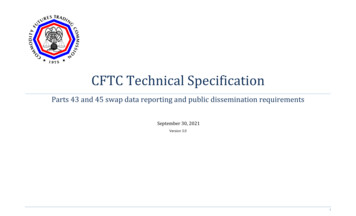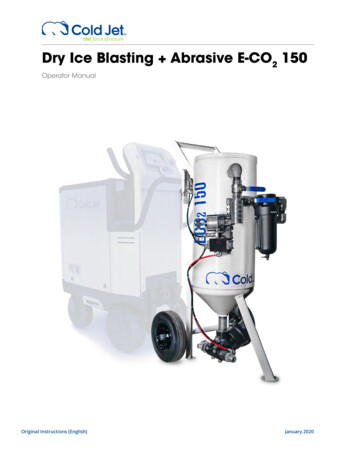
Transcription
CFTC Technical SpecificationParts 43 and 45 swap data reporting and public dissemination requirementsSeptember 30, 2021Version 3.0i
TABLE OF CONTENTS1INTRODUCTION . VI1.11.21.31.4BACKGROUND. VISTRUCTURE AND DESCRIPTION OF COLUMN HEADINGS . VIEXPLANATION OF DATA ELEMENT OR CATEGORY . IXUNIQUE PRODUCT IDENTIFIER (UPI) . XI2TECHNICAL SPECIFICATION AND VALIDATION RULES . 13APPENDIX. 37A.B.C.D.E.F.ADDITIONAL DATA ELEMENTS PUBLICLY DISSEMINATED - REQUIREMENTS FOR SDRS ONLY . 37NOTIONAL AMOUNT . 38MAPPING OF DAY COUNT CONVENTION ALLOWABLE VALUES TO ISO 20022, FPML, AND FIX/FIXML VALUES . 39VALUATION METHOD . 47COLLATERALISATION CATEGORY . 48EVENTS: VALID ACTION TYPE AND EVENT TYPE COMBINATIONS FOR PART 43 AND PART 45 REPORTING . 494.REFERENCES . 60This Technical Specification document (“Tech Spec”) provides technical specifications for reporting swap data to Swap Data Repositories (SDRs) under parts 43 and 45.ii
Index of Data ElementsDissemination timestamp . 37AAction type .8Affiliated counterparty for margin and capital indicator .32Allocation indicator .27Amendment indicator .10EBlock trade election indicator .27Buyer identifier .5Effective date . 27Embedded option type . 26Event identifier . 10Event timestamp . 10Event type. 9Exchange rate . 20Exchange rate basis . 20Execution timestamp . 28Expiration date. 27CFCall amount .12Call currency .12CDS index attachment point .25CDS index detachment point .25Central counterparty .1Cleared.1Clearing account origin .1Clearing member .1Clearing receipt timestamp .3Clearing swap USIs .2Clearing swap UTIs .2Collateralisation category .32Counterparty 1 (reporting counterparty).4Counterparty 1 financial entity indicator .5Counterparty 2 .4Counterparty 2 financial entity indicator .5Counterparty 2 identifier source .5Currency of initial margin collected .35Currency of initial margin posted .34Currency of variation margin collected.36Currency of variation margin posted .36Custom basket indicator .8Final contractual settlement date . 26First exercise date . 25Fixed rate. 20Fixing date . 16Floating rate reset frequency period. 17Floating rate reset frequency period multiplier . 17DLDay count convention .16Delta .31Dissemination identifier .37Last floating reference reset date . 31Last floating reference value . 30BIIndex factor . 25Initial margin collateral portfolio code . 33Initial margin collected by the reporting counterparty (post-haircut) . 34Initial margin collected by the reporting counterparty (pre-haircut) . 34Initial margin posted by the reporting counterparty (post-haircut) . 33Initial margin posted by the reporting counterparty (pre-haircut) . 33JJurisdiction. 30iii
NNew SDR identifier .30Next floating reference reset date .30Non-standardized term indicator .27Notional amount .10Notional amount schedule - notional amount in effect on associated effective date .11Notional amount schedule - unadjusted effective date of the notional amount .11Notional amount schedule - unadjusted end date of the notional amount .12Notional currency .11Notional quantity .13OOption premium amount .24Option premium currency .24Option premium payment date.25Original dissemination identifier .37Original swap SDR identifier .3Original swap USI .2Original swap UTI .3Other clearing exemptions - Counterparty 1 .3Other clearing exemptions – Counterparty 2 .4Other payment amount .18Other payment currency .18Other payment date .18Other payment payer .18Other payment receiver .19Other payment type .17PPackage identifier .14Package indicator .14Package transaction price.14Package transaction price currency .15Package transaction price notation .15Package transaction spread .15Package transaction spread currency .15Package transaction spread notation .16Payer identifier .6Payment frequency period .19Payment frequency period multiplier.19Platform identifier .28Portfolio containing non-reportable component indicator .33Post-priced swap indicator .21Price currency .22Price notation .22Price unit of measure .22Price,, . 21Prime brokerage transaction indicator. 28Prior USI (for one-to-one and one-to-many relations between transactions). 29Prior UTI (for one-to-one and one-to-many relations between transactions) . 29Put amount . 12Put currency . 13QQuantity frequency . 13Quantity frequency multiplier . 13Quantity unit of measure . 13RReceiver identifier . 6Reporting timestamp . 28SSeller identifier . 5Settlement currency . 26Settlement location . 26Spread . 22Spread currency . 23Spread notation . 23Strike price. 23Strike price currency/currency pair . 24Strike price notation . 24Submitter identifier . 7TTotal notional quantity . 13UUnique product identifier (UPI) . 26Unique product identifier short name . 37Unique swap identifier (USI). 29Unique transaction identifier (UTI). 30iv
VValuation amount .31Valuation currency .31Valuation method . 31Valuation timestamp . 32Variation margin collateral portfolio code . 35Variation margin collected by the reporting counterparty (pre-haircut) . 36Variation margin posted by the reporting counterparty (pre-haircut) . 35v
1 Introduction1.1 BackgroundUnder the Dodd-Frank Wall Street Reform and Consumer Protection Act, the CFTC passed several data-related swaps rules, including 17 CFR parts 43 and 45, which mandated the reporting ofswap data contracts to SDRs and the public dissemination of swap data, with the goal of bringing transparency to a previously opaque swaps market.Internationally, in 2009 the G20 leaders agreed that all over-the-counter (OTC) derivatives contracts should be reported to trade repositories (TRs) 1 to further the goals of improving transparency,mitigating systemic risk and preventing market abuse. Aggregation of the data being reported across TRs would help authorities to obtain a comprehensive view of the OTC derivatives market andits activity. In September 2014, the Financial Stability Board (FSB) published the Aggregation Feasibility Study Group (AFSG) report, endorsing certain recommendations relating to the aggregationof TR data, including developing global guidance on harmonization of data elements that are reported to TRs and are important to global aggregation across jurisdictions. The CPMI-IOSCOworking group for harmonization of critical OTC derivatives data elements was set up to implement some of the key recommendations of the 2014 FSB AFSG report and has developed globalguidance regarding the definition, format and usage of critical OTC derivatives data elements reported to TRs, including the unique transaction identifier (UTI), the unique product identifier (UPI)and other critical data elements (also known as CDE).The CFTC’s Technical Specification uses the CPMI IOSCO Technical Guidance: Harmonisation of critical OTC derivatives data elements (other than UTI and UPI) 2 (referred to as CDE TechnicalGuidance), as its base, with a majority of the data elements sourced from this CDE Technical Guidance.This Technical Specification provides the definition, format, allowable values and validation rules for the data elements that are required to be reported to the SDRs by reporting parties under therevised part 45 rule. For data elements in the CDE Technical Guidance (“CDE data elements”) adopted by the CFTC (the data element name, definition, format, and allowable values), the CFTC hastaken them on as written/prescribed by CDE. Where additional guidance is needed for CFTC reporting requirements, that guidance is provided in a footnote for that data element. This TechnicalSpecification also provides the data elements required to be reported and publicly disseminated under the part 43 rule, and any dissemination requirements for SDRs for public reporting.1.2 Structure and Description of Column HeadingsThe Technical Specification and Validation Rules table starting on page 1 contains two mai
CDE Technical Guidance. "CFTC" refers to a data element not in the published . CDE Technical Guidance. and sourced from the CFTC. (3) Category: data elements are grouped by topic or category. (4) Data Element Name: data element names used in this document may be, but are not required to beused literally. (5) Definition for Data Element:










